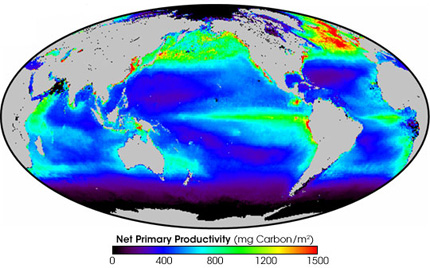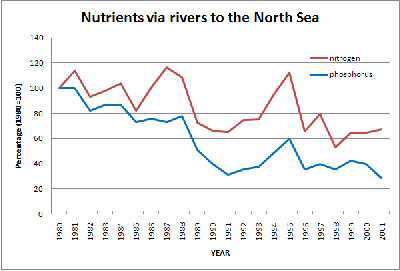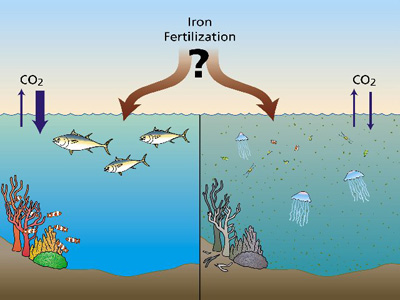2. Ecosystems (4/6)
Nutrients

To form organic matter elements like nitrogen (N) and phosphorus (P) are essential. These elements come in the chemical disguise of nutrients like nitrate (NO3-), ammonium (NH4+) and phosphate (PO43-). Nutrients in the coastal waters are more abundant than in the open ocean. Nevertheless, the growth of phytoplankton can strongly reduce the concentration of nutrients in the coastal seas, thereby exhausting the nutrient supply and reducing its own growth.
The major source of nitrogen and phosphorus in the coastal seas in Europe is input by rivers. These rivers take up these nutrients, emitted from human activities (sewers, agricultural fertilizers and manure) and transport them to the coastal waters. Over the last 20 years the supply of phosphorus has decreased more strongly than that of nitrogen.
The yearly variations in the supply of nutrients are the result of variations in water discharge, being the result of the annual rain and snow that fall on land. This implies yearly variations in the coastal concentrations of nutrients and in the last 20 years a change in the ratio of N/P. This will change the composition of the algae and might even favour species that have effects on the health of mussels and humans (toxic algae).
The amount and type of algal plankton in the river depends on the time it takes for the water to flow to the sea. In short and fast flowing rivers the algal have no time to multiply. The concentrations are low and generally dominated by the small algae that grow faster than the larger algae that can be found in lakes. Therefore the rivers bring mainly sediment, dead organic material, nutrients and pollution like heavy metals, PCBs and so on, to the coastal seas.
Nutrients from land over the years:
Mainly due to strict regulations on the use of fertilizer on land and increasing use and efficiency of waste water treatment plants, the load of N and P to coastal seas has decreased the last decades.
Note that in the years 1994 and 1995 the large discharge of water from Rhine and Maas has resulted in a temporal increase in the loading. The loading of P has decreased strongen than that of N.
Primary production
In the ocean, as on the land, photosynthesis combines energy from the Sun, carbon dioxide, and nutrients such as nitrogen and phosphorus to produce carbon-rich plant material. This natural process is called primary production and forms the base of the marine food chain. It also provides most of the oxygen in the atmosphere. Without primary production, the world would be a much different (and a good deal less pleasant) place.

Source: NASA
Iron Fertilization
In recent years there has been much news on the role of iron as micronutrient in oceanic primary production. Green algae need iron in several essential processes such as nitrogen fixation and nitrate reduction. Much iron in the oceans comes from dust picked up by the winds in the Earth's deserts.
In regions of the ocean that are distant from deserts or that are not reached by dust-carrying winds (for example, the Southern and North Pacific oceans), the lack of iron can severely limit the amount of primary production that can occur. The small amount of iron available to plants here causes phytoplankton to grow very slowly and leaves a surplus of other nutrients. This is why these areas are called High-Nutrient, Low-Chlorophyll (HNLC) regions. Some scientists have now suggested these areas could play a role in mitigating global warming. They think that by fertilizing these areas with iron as a means of increasing primary productivity carbon dioxide can be removed from the atmosphere.
Although this might look like a good option in theory there are many scientists who question the practical use. To effect the global climate the scale of these project would have to be enormous which might lead to unintended side effects like mass algal blooms and anoxic areas in the ocean. Furthermore, carbon dioxide is not the only greenhouse gas involved in global warming, the role of other gasses would need to be assessed as well.


